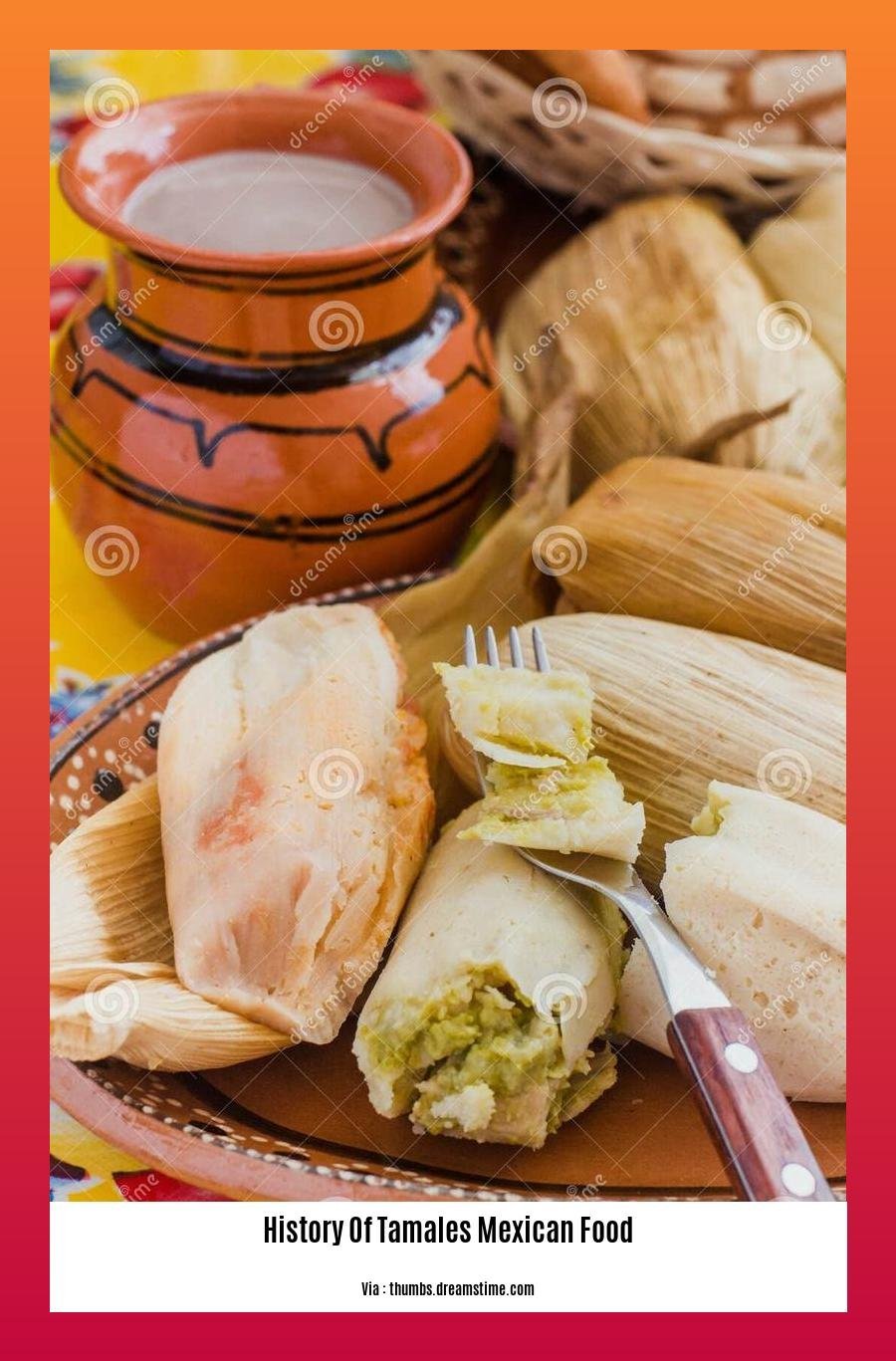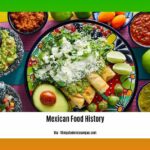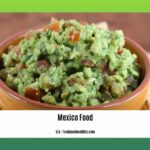In the rich tapestry of Mexican cuisine, few dishes hold a more prominent place than the tamale. A culinary masterpiece crafted from nixtamalized corn dough and a variety of fillings, the tamale has transcended time, becoming a cornerstone of Mexican food culture. Embark on a culinary journey through the history of tamales, uncovering the stories, traditions, and flavors that have made them a beloved delicacy across the ages. From humble origins to their starring role in contemporary Mexican gastronomy, discover how tamales have shaped the culinary identity of a nation.
Key Takeaways:
- Tamales have a rich history dating back to 8000 BCE in Mesoamerica.
- Indigenous cultures like the Aztecs and Maya crafted tamales from corn dough, filled them with diverse ingredients, and wrapped them in leaves.
- The Spanish Conquistadors recorded the existence of tamales in the 16th century.
- Today, tamales are relished in Mexico, Central America, and the southwestern United States.
- Ancient civilizations in Mexico developed tamale cooking techniques as early as 8000 BCE.
- Mentions of tamales can be found in Aztec texts and the journals of Spanish conquistadors.
- The Aztecs and Mayans favored tamales as a portable meal.
- By the 1870s, tamales ventured into the American South, sold by vendors on the streets of Los Angeles.
- In Mississippi, a spicier, sometimes fried version of the tamale known as the “hot tamale” emerged.
History of Tamales: A Cornerstone of Mexican Food Culture
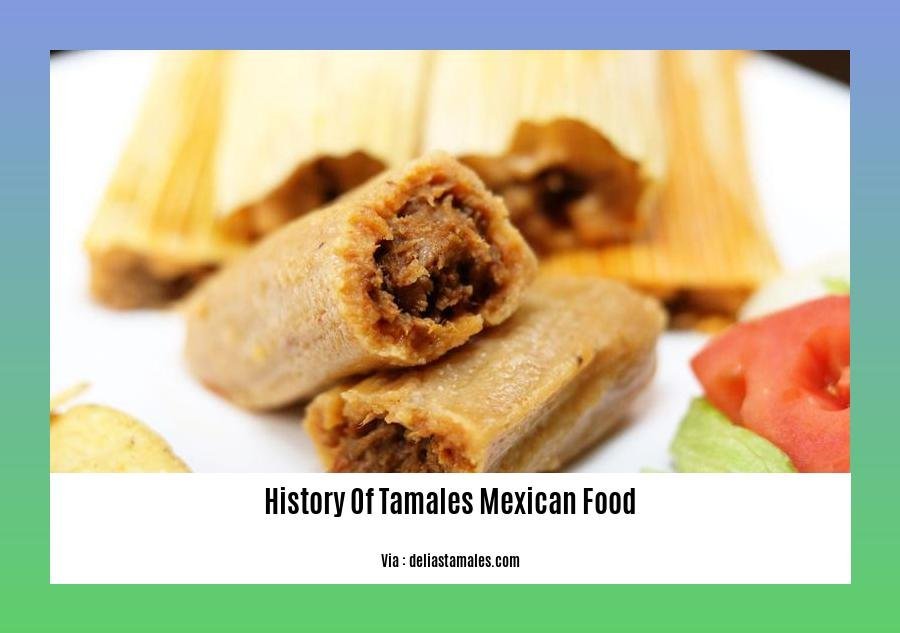
Imagine sinking your teeth into a piping hot tamale, the savory filling bursting with flavor, wrapped in a tender corn husk that peels away effortlessly. This delightful delicacy, deeply rooted in Mexican culinary heritage, has a captivating journey that spans centuries.
The Origins of a Mesoamerican Staple
Tamales, a quintessential part of Mexican cuisine, trace their lineage back to Mesoamerica, where they were born among ancient civilizations such as the Aztecs, Mayans, and others around 8000 BC. These indigenous cultures crafted tamales from corn dough, enveloping them in leaves and steaming them to perfection.
A Culinary Legacy Enduring Through Time
📜 The enduring legacy of tamales is etched in historical texts, including Aztec codices and the journals of Spanish conquistadors. The 16th-century writings of these explorers reveal the prevalence of tamales in Mesoamerican cuisine, a testament to their timeless appeal.
Tamales: A Journey Across Borders
The arrival of the Spanish in the 16th century marked a significant turning point in the history of tamales. The Spanish were captivated by this culinary delight and introduced it to their homeland, where it quickly gained popularity.
From Mexico, tamales embarked on a culinary odyssey, spreading their魅力nto Central America and the southwestern United States. Today, they are celebrated in various regions, each with its unique interpretation of this beloved dish.
Diversity in Unity: Regional Variations of Tamales
In the tapestry of Mexican cuisine, tamales are a canvas of culinary artistry, showcasing a remarkable diversity of regional variations. Each region boasts its signature style, reflecting the rich cultural heritage of Mexico.
From the classic corn husks to plantain leaves and banana leaves, the choice of wrapper imparts a distinctive flavor and texture to each tamale.
A Symbol of Festivity and Celebration
In Mexico, tamales are more than just a culinary delight; they hold a special place in the cultural fabric of the nation. They symbolize festivity, often gracing the tables during celebrations like Christmas, Day of the Dead, and other joyous occasions.
Tamales serve as a culinary bridge, connecting people and fostering a sense of community. Whether it’s a family gathering or a street fair, the aroma of tamales in the air heralds a time of merriment and shared joy.
A Culinary Time Capsule: Tamales as Historical Artifacts
Tamales offer a glimpse into the past, serving as culinary time capsules that have preserved ancient techniques and flavors. They embody the ingenuity and culinary expertise of our ancestors, a testament to the enduring legacy of Mexican cuisine.
Conclusion: Tamales, a Culinary Tapestry
Tamales, with their rich history, regional diversity, and symbolic significance, stand as a cornerstone of Mexican food culture. They are a testament to the creativity, resilience, and celebratory spirit of the Mexican people.
So, the next time you savor the delectable taste of a tamale, remember the journey it has undertaken – a journey that spans millennia, cultures, and continents. It’s a journey that has transformed a humble corn-based dish into a beloved symbol of Mexican culinary heritage.
In examining the history of sugaring, one is transported back in time to the ancient practice of hair removal, while delving into the history of Vietnamese coffee, will usher you into the rich tapestry of flavor, cultivation, and global impact of this beloved beverage.
The filling of tamales has evolved over time, with traditional fillings such as beans, squash, and meat being joined by a wide variety of modern ingredients.
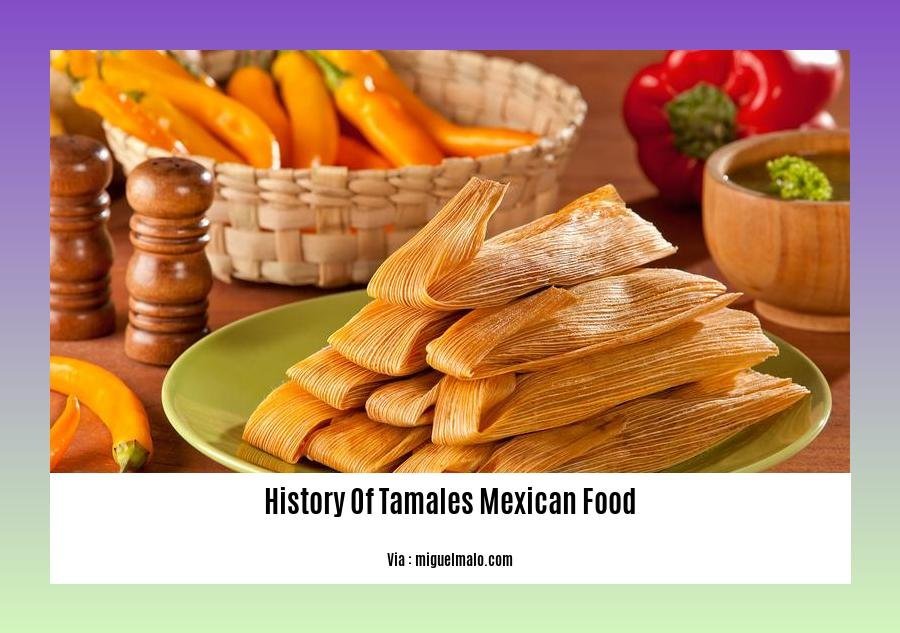
Tamales, a beloved dish in Mexican cuisine, boast a rich history and an ever-evolving array of fillings. Originally, these fillings consisted of simple ingredients such as beans, squash, and meat, reflecting the humble origins of tamales as a portable food for soldiers and travelers.
Over time, the fillings of tamales expanded to include a wide variety of modern ingredients, mirroring the evolving tastes and culinary innovations of Mexican cuisine. Today, tamales can be filled with everything from traditional favorites like cheese and chiles to more contemporary ingredients like seafood, exotic vegetables, and even fruits. This diversification has transformed tamales into a versatile dish that can cater to diverse preferences and dietary restrictions.
Key Takeaways:
- Tamales have a long history, dating back to pre-Columbian times when they were crafted by ancient civilizations.
- They were initially filled with simple ingredients like beans, squash, and meat, serving as portable food for soldiers and travelers.
- Today, tamales feature diverse fillings, including traditional favorites like cheese and chiles, as well as contemporary ingredients like seafood, vegetables, and fruits.
- This evolution reflects the changing tastes and culinary advancements of Mexican cuisine.
Sources:
- A Brief History of Tamales – Eddie’s Mexican Restaurant
- Tamales: A History of the Mexican Cornmeal Dish
Tamales are a popular street food in Mexico and are often sold from carts or at markets.
Tamales, a Mexican culinary delight, are regarded as the foundation of Mexican gastronomy. They are a traditional food that has stood the test of time, tantalizing taste buds with its remarkable history and diversity. Prepared using corn masa dough, tamales are enveloped in leaves and steamed to perfection, offering a savory experience that is truly unique to Mexican cuisine.
The Allure of Tamales as Street Food
Tamales are a popular street food in Mexico and are often sold from carts or at markets. They have become an emblem of Mexican street cuisine, providing a convenient and delicious option for those on the go. From bustling city streets to vibrant marketplaces, the aroma of tamales wafts through the air, inviting passersby to indulge in this culinary treasure.
Regional Variations: A Testament to Culinary Diversity
The beauty of tamales lies in their regional variations, reflecting the rich tapestry of Mexican culture. From the spicy delights of the north to the sweet temptations of the south, each region boasts its own unique interpretation of this beloved dish.
-
Northern Tamales: Characterized by their savory fillings, such as pork, beef, or chicken, and a distinctive spicy flavor.
-
Southern Tamales: Known for their sweet fillings, such as fruits, chocolate, or nuts, and a delicate sweetness that tantalizes the taste buds.
-
Central Tamales: Often featuring a combination of savory and sweet fillings, such as pork with pineapple or chicken with mole, showcasing the culinary creativity of the region.
The Cultural Significance of Tamales
Tamales go beyond mere sustenance; they hold a profound cultural significance in Mexican society. They are deeply intertwined with festivals and celebrations, serving as a symbol of unity, family, and joy.
-
Day of the Dead (Dia de los Muertos): Tamales play a central role in this annual celebration, honoring the memory of departed loved ones. They are believed to serve as a bridge between the living and the dead, connecting families across realms.
-
Christmas (Navidad): Tamales are an indispensable part of the traditional Christmas feast, bringing families together to share in the warmth and joy of the season.
Key Takeaways:
- Tamales are a popular street food in Mexico, sold from carts or in markets, offering a convenient and delicious option for those on the go.
- Tamales exhibit regional variations, reflecting the diverse culinary traditions of Mexico, with distinct fillings and flavors.
- Tamales hold cultural significance, deeply intertwined with festivals and celebrations, symbolizing unity, family, and joy.
Sources:
- A Taste of Mexico: Tamales
- All About Mexican Cuisine: Tamales
Tamales are also a popular dish for celebrations and holidays, such as Christmas and Dia de los Muertos, and are often made in large quantities to be shared with family and friends.
Sharing food is how we show our love and care in Mexico. Tamales are a centerpiece of Mexican celebrations. They’re a symbol of unity, community, and the warmth of family.
Families often gather to make tamales together, sharing in the labor and the joy of creating something delicious. The aroma of tamales cooking fills the air, creating a sense of anticipation and excitement.
When the tamales are finally ready, they’re shared with friends and family, both near and far. It’s a time to celebrate life, love, and the rich traditions of Mexican culture.
Tamales are a gift, a symbol of our heritage, and a way to connect with our loved ones. They’re a reminder that even though life can be busy, there’s always time to slow down, gather with the people you love, and enjoy a delicious meal together.
Key Takeaways:
- Tamales are a traditional Mexican dish made from corn dough that is steamed in a corn husk or banana leaf.
- Tamales are a popular dish for celebrations and holidays, such as Christmas and Dia de los Muertos, and are often made in large quantities to be shared with family and friends.
- Tamales come in diverse regional variations across Mexico, with different fillings, wrappings, and cooking methods.
- Tamales are not only a delicious food but also a symbol of unity, community, and the warmth of family.
Sources:
* TasteAtlas: Tamal
* Culture Trip: Everything You Need to Know About Tamales
FAQ
Q1: What are the earliest known origins of tamales?
A1: Tamales have a rich and ancient history, with evidence suggesting their existence among indigenous cultures in Mesoamerica, like the Aztecs and Mayans, dating back to around 8000 BC.
Q2: How did tamales become popular in the modern era?
A2: Tamales gained widespread recognition beyond their indigenous origins during the Spanish Colonial period. The Spanish Conquistadors documented the existence of tamales in the 16th century, leading to their eventual spread throughout Mexico and beyond.
Q3: What are some regional variations of tamales in Mexico?
A3: The diversity of Mexican cuisine extends to tamales as well. In central regions, tamales often feature savory fillings, while in the southern states, sweet fillings like fruits and chocolate are commonly found. This regional variety reflects the unique culinary traditions of each region.
Q4: Why are tamales considered a symbol of festivity in Mexico?
A4: Tamales hold a special place in Mexican celebrations, serving as symbols of unity, family, and cultural pride. They are often prepared and shared during religious holidays, national festivities like Independence Day, and other special occasions, representing the joyous and communal spirit of these gatherings.
Q5: What are some popular fillings used in tamales?
A5: Tamales offer a wide range of flavors and fillings to cater to various preferences. Common fillings include meats like pork, chicken, and beef, as well as vegetarian options such as beans, cheese, vegetables, and even sweet fillings like fruits and chocolate. The diversity of fillings contributes to the popularity and versatility of tamales in Mexican cuisine.
- Unveiling the Enigma: Mansoureh Khojasteh Bagherzadeh’s Public Appearances & Private Life in Iran - July 18, 2025
- Unveiling the Mystery: Mansoureh Khojasteh Bagherzadeh’s Husband: A Rare Glimpse into a Private Life - July 18, 2025
- Unveiling Masoud Khamenei’s Mother: Power, Influence, and Iran’s Future - July 18, 2025
